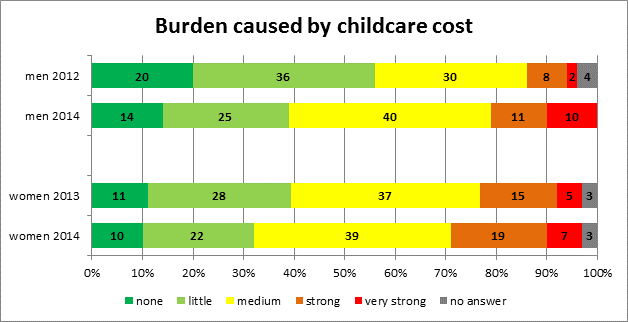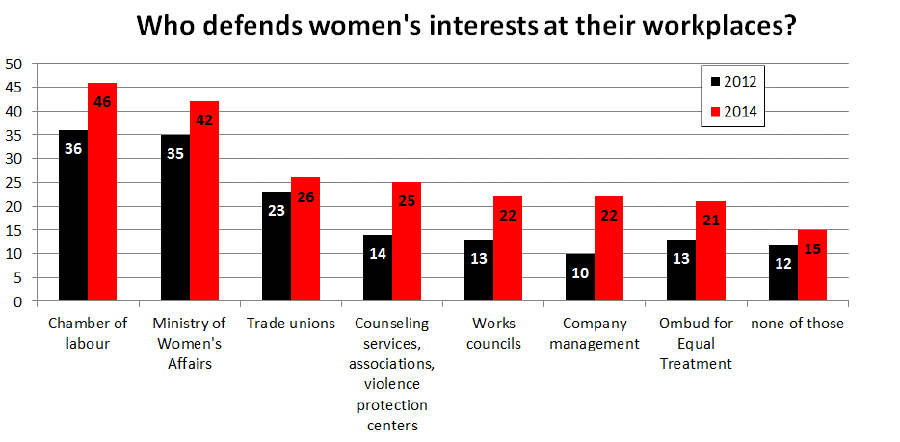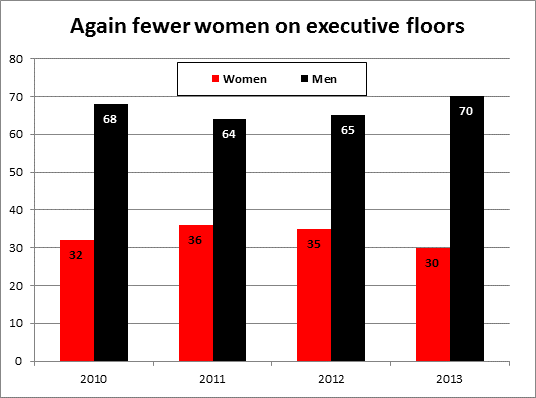Dieses Bild teilen über:
Since the analysis of the survey conducted for the Work Climate Index in 2012, the percentage of employees who are satisfied with the available childcare offerings has dropped from 55 to 52 percent.
The lack of childcare programs adapted to the needs of employees remains a problem. Even though, according to the Work Climate Index, the proportion of women and men with children under 15 in their households has declined from 31 percent (2012) to 26 percent (2014), this development apparently has not eased the pressure when it comes to childcare needs.
The assessments of the available childcare facilities by male and female respondents are becoming increasingly similar: currently, 14 percent of women (2012: 21 percent) and 11 percent of men (2012: 7 percent) say that they are (very) dissatisfied with them. One reason for this may be rising costs, even though free kindergartens are provided in some regions. More specifically, in 2014, 36 percent of women and 42 percent of men consider the cost burden to be (very) high. Two years ago, 26 percent of women and only 12 percent of men felt this way. .
Since 2012, there has been a positive development with regard to business enterprises that provide support to employees who have children: 23 percent of employees responded in the affirmative when asked whether their employers have family-friendly policies, almost double the figure from 2012.
These family-friendly policies, however, are mainly limited to preferential treatment in vacation planning (73 percent) and to support provided by co-workers (46 percent). In addition, financial allowances are more frequent (13 percent) now, and there exists a greater number of company kindergartens (20 percent). When it comes to family-friendly working hours, i.e., flexible hours to the benefit of employees based on special flextime schemes for parents, the opinions of respondents are now more critical than in 2012: Currently, 46 percent say that there are family-friendly work time regulations in place at their companies – down from 61 percent in 2012.
Summing up, the childcare programs and support offered in business enterprises are developing and improving only at a very slow pace. Special consideration should be given to mitigating the burden caused by childcare costs.
The existing tax deduction model benefits higher-income parents much more than for example part-timing single mothers.

DR. JOHANN KALLIAUER, President of the Upper Austrian Chamber of Labour
According to the Work Climate Index, the percentage of employees who are satisfied with the currently available childcare offerings has decreased by 3 percent over the last two years. High costs in particular, but also inflexible opening hours and long periods of closure in summer have repeatedly been reasons for complaint and criticism.
The
Chamber of Labor has championed the provision of more and better childcare
facilities and programs for several years now. Many objectives have already
been achieved, as is apparent for example from the "Upper Austrian
Childcare Atlas" published at annual intervals. However, the analysis of
recent data from the Work Climate Index survey underpins that many problems
still remain unsolved. Therefore, the Chamber of Labor will not cease to stand
up for the interests and concerns of women. This applies not only to childcare,
but also to matters of gender equality. Equal pay for comparable work has not
yet become a reality everywhere. Going forward, we remain committed to ensuring
that this income gap will finally be closed
Generally, a slightly smaller number of women than in 2012 feel disadvantaged at their jobs. The problems, however, are in the details.
Only two years ago, 25 percent of working women felt disadvantaged (very) frequently to occasionally. In 2014, it was 22 percent.
The main problem continues to be the pay: 38 percent of women say that they are occasionally to (very) frequently put at a disadvantage when it comes to their wages/salaries (vs. 42 percent in 2012).
At least, the situation of working women has improved slightly in a few areas over the last two years. While back in 2012, 32 percent felt discriminated against with regard to promotions and career advancement, this number has meanwhile dropped to 26 percent.
Furthermore, women now receive more frequent appreciation of their work: 16 percent still feel disadvantaged (vs. 24 percent in 2012). Currently, 23 percent of women feel at a disadvantage in job application and recruitment processes (2012: 27 percent). Nevertheless, 21 percent of working women are very satisfied with their opportunities for career advancement and development, and another 31 percent are satisfied.
Almost half (46 percent) of the working women believe that the Chamber of Labor is committed to the goal of achieving gender equality at work. That is a ten percent increase since 2012. The Austrian Ministry of Women's Affairs achieved a similarly good rating, that is, 42 percent (up seven percent), followed by the trade unions with 26 percent (up three percent). 22 percent feel supported by their works council, tantamount to a nine percent increase.
It is mainly younger women (15 to 39 years) who feel supported by the Chamber of Labor, while older women rather name trade unions or works councils as providers of assistance. As many as 15 percent say that do not receive help from anywhere.

Almost one third of women have already experienced personal discrimination or harassment at the workplace. This situation is improving only slowly.
Even today, women continue to be harassed and put under pressure at
their workplaces.
Derogatory remarks toward women in the workplace are still most common:
22 percent of women have already experienced such remarks, a slight improvement
by 3 percent since 2012. At eight percent, the percentage of women who have
even been exposed to physical abuse and sexual harassment at work has remained
unchanged since 2012.
Slightly over one third of working women (34 percent), versus only 23 percent of men, have to cope with seven or more work-related physical stress factors. When adding those women who have to come to terms with five to six physical stress factors at their jobs, a total of 49 percent of working women are exposed to enormous physical stress.
More than half of the women (57 percent) in the public sector feel at least occasionally put at a disadvantage at their jobs. In trade, this figure is 21 percent, with three percent saying that they are frequently discriminated against. 17 percent of women employed in the education sector responded in the affirmative when asked whether they have been put at a disadvantage, six percent even say that they are exposed to severe and/or frequent discrimination.
When it comes to workplace health promotion, working women fare slightly better than men: 40 percent of men and 45 percent of women have access to in-house health promotion programs at their workplaces. This also implies, however, that there exist no workplace health promotion programs for the majority of employees.
Economic and socio-political discussions are accompanied by a cornucopia of figures and data, many of which are aimed at facilitating welfare cuts and curtailing distributive justice.
The Austrian Work Climate Index, however, is a benchmark for economic and social change as seen by employees. It examines their assessments with respect to society, company, work and expectations. Unlike the standard key indicators of economic development, the Work Climate Index captures the subjective dimension, expanding our knowledge about economic developments and their implications for society.
The Work Climate Index is calculated based on quarterly surveys among employees in Austria. The random sample of approx. 4,000 respondents each year is selected with a view to being representative so as to enable telling conclusions regarding the feelings and the wellbeing of all employees. Since the spring of 1997, the Work Climate Index has been calculated twice a year. There are also supplementary special evaluations.
For current results and background information, please visit www.arbeitsklima.at. There, you will find the comprehensive work climate database for evaluations. In addition, you can also calculate your personal job satisfaction index online within just a few minutes. Another online service is our Managers' Monitor. It provides answers to questions about the current job satisfaction level among Austria's managers.
Physically and psychologically stressful jobs negatively impact the health of those performing them. There exist some differences between women and men as to how this manifests itself.
According to the Austrian Occupational Health Monitor (Österreichischer Arbeitsgesundheitsmonitor), a continuous study on factors impacting the health of employees, the most frequent job-related health problems include headache and back pain. Women, in particular, frequently complained about headaches or migraine (61 percent), whereas these health problems were found in only 40 percent of male employees. Exhaustion, fatigue, and dejection were observed frequently in 53 percent of women and in 41 percent of men. One fifth of working women suffered from very frequent or frequent neck or back pain, while 17 percent of men reported such complaints.
More and better workplace health promotion is necessary, but also the steady improvement of working conditions. Otherwise, in the long term, not only the employees will pay a steep price with their health, but also businesses and society at large will pay dearly in economic terms.
Less than one third of managers are women. This percentage has been stagnating for years. Also, the salaries of female managers continue to be lower than that of their male counterparts.
The fact that the percentage of female managers is rising so slowly is due to a high share of part time work, on the one hand, and to careers interrupted by baby breaks, on the other. The segments where women are most likely to advance to a managerial position are Trade (13 percent) as well as Healthcare and Nursing Professions (14 percent). Ten percent advance to managerial positions in Industry and Commerce, however, only five percent do so in the public sector.
Women in management positions earn about € 700 less than men – three years ago, the difference was only € 500. One of the reasons for this are the sectors in which women hold leading positions: after all, wages and salaries in the trade segment are lower than for example in the industrial sector. Another reason is that many of the female managers work in lower management levels.
A mere 26 percent of female managers have children in their households. This highlights how important it is to provide needs-based high quality childcare for working women. Only if adequate childcare made available will more women be able to work in management positions.

© 2026 AK Oberösterreich | Volksgartenstrasse 40 4020 Linz, +43 50 6906 0